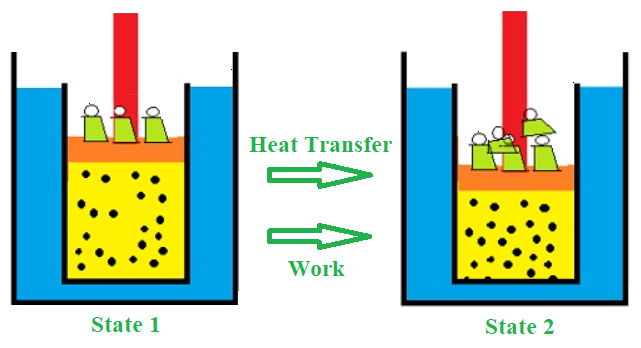热力学第一定律
热力学规则很容易说明。你知道热力学原理适用于人体吗?当我们在一个人满为患的房间里时,我们会开始出汗并感到热,如果房间很小,汗水就会变得过多。发生这种情况是因为您的身体正试图自行冷却,而热量通过排汗从身体转移。这就需要应用热力学第一定律。
在继续讨论热力学第一定律之前,我们必须首先理解功和热之间的关系,以及内能的概念。能量与物质一样,始终是守恒的,这意味着它不能产生或破坏,但可以转化为不同的形式。热力学性质引用与系统分子有关的能量,包括势能和动能,称为系统的内能。
当一个系统由于功、热和内能的关系而发生变化时,就会发生多种能量转移和转换。然而,这些交换中总能量的净变化为零。同样,热力学第一定律解释了热是一种能量。这意味着能量守恒定律支配着热力学过程。能量守恒定律是热力学基本定律的别称。
什么是热力学第一定律?
The first law of thermodynamics states that the total energy of an isolated system is constant. Energy can be transformed from one form to another, but can neither be created nor destroyed.

热力学第一定律。
内能是处于平衡状态的热力学系统中的状态变量。两个系统之间的内能差等于传入系统的热量减去系统所做的功。
根据热力学第一定律,宇宙的能量是不变的。它可以在系统和周围环境之间转移,但不能生产或销毁。该法主要关注由功和热传递引起的能量状态。它重新解释了能量守恒的概念。
我们可以用热机这个流行的例子来帮助你理解第一定律的含义。热能在热机中转化为机械能,过程也相反。大多数热机被归类为开放系统。热机的主要工作概念是利用工作流体(通常是气体)的热量、压力和体积之间的许多相互作用。气体变成液体然后又变成气体的情况并不少见。
热力学方程第一定律
根据这个规则,供给系统的一部分热量被用来改变内部能量,而剩余的热量被系统用来做功。数学上,
ΔQ = ΔU + ΔW
where
- ΔU is the change in internal energy of the system,
- ΔW is the work done by the system, &
- ΔQ is the heat supplied to the system.
如果 Q 为正,则有净热传递到系统中,如果 W 为正,则系统做功。结果,正 Q 为系统提供能量,而正 W 耗尽它。当对系统施加热量时,内能趋于上升,反之亦然。
要记住的事情
- 理想气体的内能只是温度的函数。
- 内能是系统的点函数和属性。内能是广义的(与质量相关的)特性,而比能是狭义的(与质量无关的)属性(与质量无关)。
- 在孤立系统中,能量 (E) 始终是恒定的。
第一定律的局限性
- 热力学第一定律有一个局限性,它没有说明热流的方向。
- 颠倒程序是不可行的。实际上,热量并没有完全转化为劳动力。如果将所有热量转化为功是可行的,我们可以通过从海水中提取热量来使船只穿越海洋。
- 它不区分过程是否自发。
Perpetual Motion Machine of First Kind (PMM1)
It is impossible to build a machine that can do mechanical work indefinitely without spending any energy. The perpetual motion machine of the first type is a hypothetical device like this. These machines contradict the first rule of thermodynamics and do not exist in the actual world.
热力循环
- 孤立系统中的总能量保持不变。提供给系统的净热量等于系统在热力学循环中所做的净功。例如,我们使用的电池将化学能转化为电能。电灯泡也将电能转化为光能。
- 在气体上或由气体完成的功不仅取决于气体的初始和最终状态,还取决于导致最终状态的过程或路径。传入或传出气体的热量也由开始和最终状态以及产生最终状态的过程决定。
- 内能与物体在地球上方一定高度的势能或运动物体的动能相同。热力学系统的内部能量转换为动能或势能,其方式与势能转换为动能的方式相同,同时保留了系统的总能量。内部能量可以以与势能相同的方式存储在系统中。热力学的第一条规则允许广泛的潜在系统状态,但在自然界中只能看到少数。
封闭系统的热力学第一定律
施加的压力和由于施加的压力而发生的体积变化的乘积是封闭系统所做的功:
W = – P ΔV
where
- P denotes the system’s constant external pressure, and
- V denotes the volume change.
This is referred to as Pressure-Volume work.
系统的内部能量会随着跨越其极限的工作相互作用而上升或下降。当系统做功时,内能增加,但当系统做功时,内能减少。系统与其周围环境之间的任何热交换都会改变系统的内部能量。然而,内能的总变化总是为零,因为能量保持不变(根据热力学第一定律)。如果系统失去能量,它会被周围环境吸收。如果能量被吸收到系统中,则能量必须已被环境释放:
ΔUsystem = −ΔUsurroundings
where
- ΔUsystem is the change in the total internal energy of the system, and
- ΔUsurroundings is the change in the total energy of the surrounding.
封闭系统涉及四个过程:
- 等温过程:温度恒定的过程。此过程的内部热能始终为零。
- 绝热过程:热量既不离开也不进入系统的过程。此过程的热传递始终为零。
- 等压过程:外部压力始终恒定的过程。
- 等容过程:体积始终恒定的过程。此过程完成的工作始终为零。
示例问题
问题 1:找出一个具有恒定体积的系统的内能并且系统周围的热量增加了 30 J?
解决方案:
Given that,
Heat Transfer, ΔQ = 30 J
For constant volume, ΔV = 0
W = P ΔV
= 0
The formula for internal energy is given as:
ΔU = ΔQ – W
= 30 J – 0
= 30 J
Hence, the change in internal energy of the system is 30 J.
问题 2:如果向系统添加 2000 J 的热量并做 1500 J 的功,计算系统内能的变化。
解决方案:
Given:
Heat added to a system, ΔQ = 2000 J
Work done on the system, W = 1500 J
The formula for internal energy is given as:
ΔU = ΔQ – W
= 2000 J – 1500 J
= 500 J
Hence, the change in internal energy of the system is 500 J.
问题3:热力学第一定律对环境的意义是什么?
回答:
Energy cannot be generated or destroyed, according to the first law; it can only be changed from one form to another. All living species on Earth rely on the sun for their energy. Photosynthesis is the process through which plants transform solar energy into chemical energy. These energies are not returned to the solar system by the plants; instead, they are passed on to herbivores that eat green vegetation. Carnivores use some energy gained by herbivores, while some energy obtained by herbivores is passed to decomposers when the herbivores die.
问题 4:热力学第一定律。
回答:
The First Law of Thermodynamics states that heat is a form of energy, and thermodynamic processes are therefore subject to the principle of conservation of energy. This means that heat energy cannot be created or destroyed. It can, however, be transferred from one location to another and converted to and from other forms of energy.
问题 5:密闭容器中的气体被 20J 的能量加热,导致容器的盖子以 4N 的力上升 3m。系统能量的总变化是多少?
解决方案:
Given:
Heat supplied to the container, ΔQ = 20 J
Rise in lid of the container, Δx = 3 m
Force applied on the container, F = 4 N
We are not given a value for work, but we can solve for it using the force and distance. Work is the product of force and displacement.
W = F Δx
= 4 N × 3 m
= 12 J
The formula for internal energy is given as:
ΔU = ΔQ – W
= 20 J – 12 J
= 8 J
Hence, the change in internal energy of the system is 8 J.